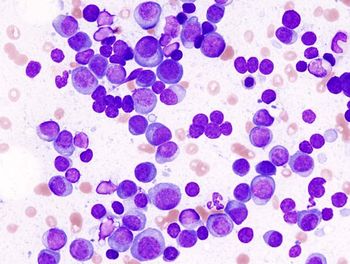
- Oncology Vol 28 No 1S
- Volume 28
- Issue 1S
(P025) Outcomes of Nonmelanoma Skin Cancer in Immunosuppressed Patients Treated With Surgery and Radiation Therapy
The outcomes of nonmelanoma skin cancer (NMSC) in immunosuppressed and immunocompetent patients treated with surgery and radiation therapy (RT) are evaluated and compared.
Adam A. Garsa, MD, Sarah T. Arron, MD, PhD, Sue S. Yom, MD, PhD; University of California, San Francisco
Purpose: To evaluate and compare the outcomes of nonmelanoma skin cancer (NMSC) in immunosuppressed and immunocompetent patients treated with surgery and radiation therapy (RT).
Methods: Between January 2004 and October 2013, 75 NMSCs in 74 patients were treated with surgery and RT with curative intent. Patients with distant metastasis at diagnosis were excluded. Patients with HIV, chronic lymphocytic leukemia (CLL), or solid-organ transplantation were classified as immunosuppressed. Rates of locoregional control and distant metastasis-free survival were estimated using the Kaplan-Meier method. Cox proportional hazards model was used for univariate and multivariate analysis. A
P value < .05 was considered statistically significant.
Results: Mean follow-up was 18.6 months (range: 2–71 mo). The mean age was 67 years (range: 41–91 yr). Of the 75 lesions, 61 (81%) were squamous cell carcinomas (SCCs) and 14 (19%) were basal cell carcinomas (BCCs); 72 lesions (96%) were in the head and neck. Staging was as follows: stage I 8%, stage II 42.7%, stage III 13.3%, and stage IV 36%. Lymph nodes were pathologically involved in 17 cases (22.7%). Disease was recurrent in 44 cases (58.6%). Perineural invasion was present in 38 cases (50.6%). In-transit metastases were present in six patients with SCC, four of whom were immunosuppressed.
RT was delivered to a median dose of 64 Gy (range: 45–74.8 Gy) in a median of 30 fractions (range: 5–45 Gy). Six patients also received adjuvant chemotherapy. Twenty-three patients were immunosuppressed, including 7 patients with HIV, 5 with CLL, and 11 with solid-organ transplantation. There were no significant differences in the patient- and treatment-related characteristics between the immunosuppressed and immunocompetent groups.
The Kaplan-Meier–estimated local control, regional control, and distant metastasis-free survival at 2 years were 77.4%, 87.1%, and 93.6%, respectively. Univariate analysis to identify variables associated with recurrence included the following variables: histology, primary tumor stage, nodal stage, stage grouping, margin status, recurrent tumor, perineural invasion, named nerve involvement, in-transit metastasis, extranodal extension, dose, and immunosuppression. In-transit metastasis was the only significant predictor of local recurrence (hazard ratio [HR] = 6.94; 95% confidence interval [CI], 1.82–26.3; P = .004). Both immunosuppression and in-transit metastasis were significant predictors of regional recurrence on univariate analysis. However, only in-transit metastasis remained significant on multivariate analysis (HR = 12.7; 95% CI, 3.04–52.6; P < .001). In-transit metastasis was the only predictor of distant metastases (HR = 45.5; 95% CI, 4.69–500; P = .001). Of the six patients with in-transit metastases, four developed locoregional recurrence and three developed metastatic disease, all within 4 months of the completion of RT. Three of the four patients with in-transit metastases who developed recurrence were immunosuppressed. Testing for sets of multiple negative factors other than in-transit metastases revealed no combinations predictive of recurrence.
Conclusions: In patients with high-risk NMSC treated with surgery followed by RT, in-transit metastasis is significantly associated with worse locoregional control and with a higher risk of distant metastasis. In-transit metastases were only observed in SCC and were more common in immunosuppressed patients. Intensification of therapy and reduction of immunosuppression should be part of the treatment strategy for patients with in-transit metastases.
Articles in this issue
Newsletter
Stay up to date on recent advances in the multidisciplinary approach to cancer.

















































































